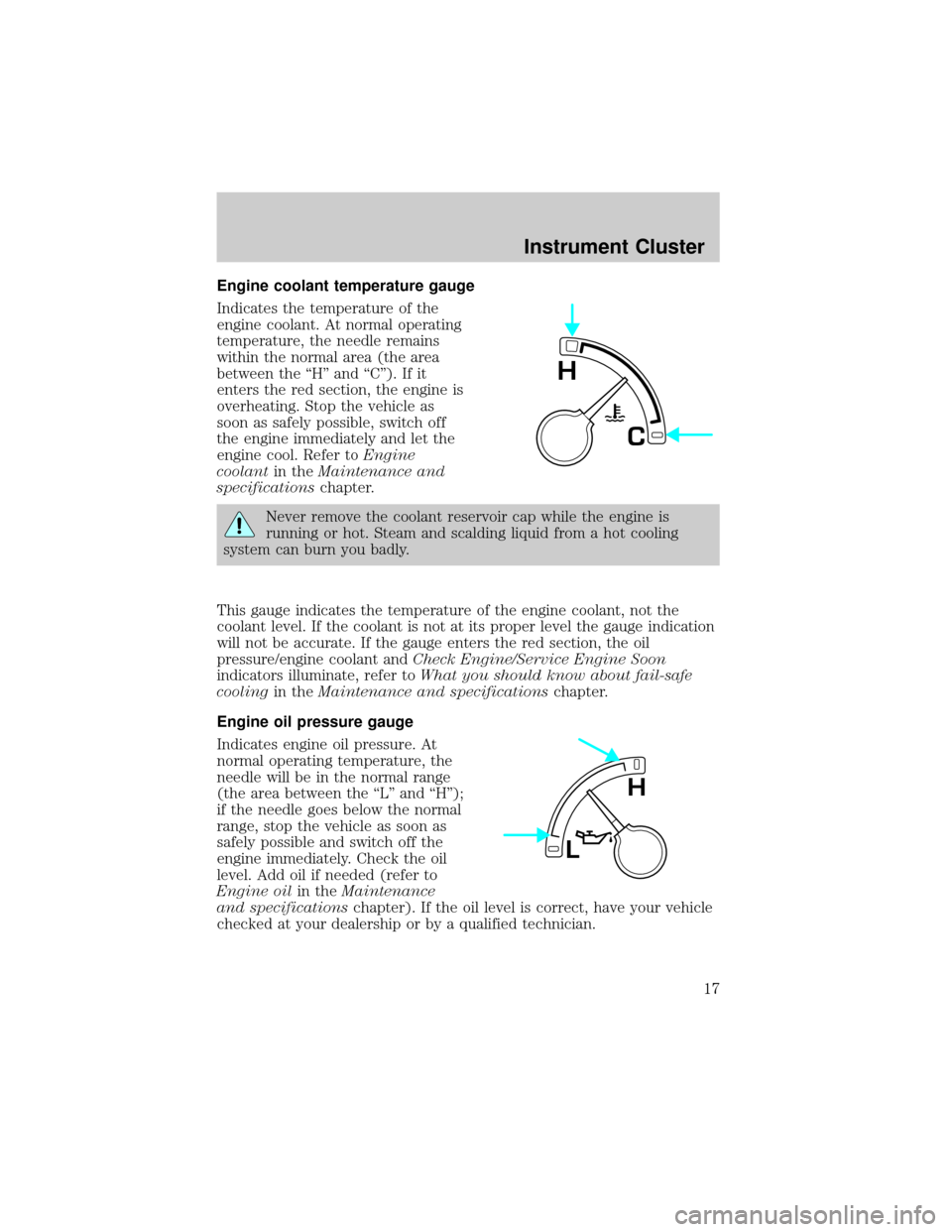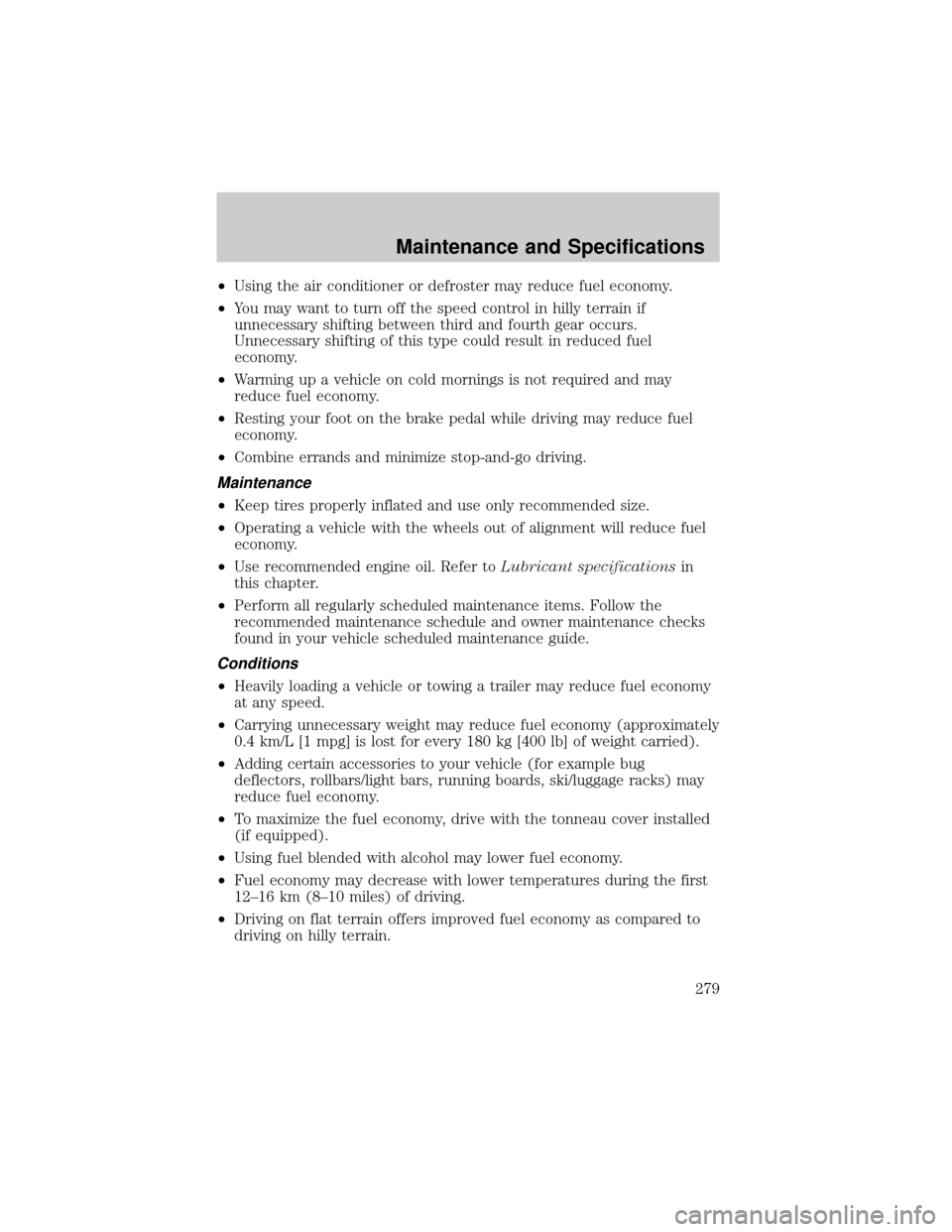Page 9 of 320
Vehicle Symbol Glossary
Child Safety Door
Lock/Unlock
Interior Luggage
Compartment Release
Symbol
Panic AlarmEngine Oil
Engine CoolantEngine Coolant
Temperature
Do Not Open When HotBattery
Avoid Smoking, Flames,
or SparksBattery Acid
Explosive GasFan Warning
Power Steering FluidMaintain Correct Fluid
LevelMAX
MIN
Emission SystemEngine Air Filter
Passenger Compartment
Air FilterJack
Check fuel capLow tire warning
Introduction
9
Page 13 of 320
Safety belt
Illuminates to remind you to fasten
your safety belts. For more
information, refer to theSeating
and safety restraintschapter.
Air bag readiness
Illuminates to confirm that the air
bags (front or side) are operational.
If the light fails to illuminate,
continues to flash or remains on,
have the system serviced immediately.
Charging system
Illuminates when the battery is not
charging properly.
Oil pressure/Engine coolant
Illuminates when the engine coolant
temperature is above the normal
range or the engine oil pressure is
below normal range. Check the
engine oil and coolant level refer to
Adding engine oilandAdding coolantin theMaintenance and
specifications chapter.
Low fuel
Illuminates when the fuel level in
the fuel tank is at, or near, empty
(refer toFuel gaugein this chapter
for more information).
LOW
FUEL
Instrument Cluster
13
Page 17 of 320

Engine coolant temperature gauge
Indicates the temperature of the
engine coolant. At normal operating
temperature, the needle remains
within the normal area (the area
between the ªHº and ªCº). If it
enters the red section, the engine is
overheating. Stop the vehicle as
soon as safely possible, switch off
the engine immediately and let the
engine cool. Refer toEngine
coolantin theMaintenance and
specificationschapter.
Never remove the coolant reservoir cap while the engine is
running or hot. Steam and scalding liquid from a hot cooling
system can burn you badly.
This gauge indicates the temperature of the engine coolant, not the
coolant level. If the coolant is not at its proper level the gauge indication
will not be accurate. If the gauge enters the red section, the oil
pressure/engine coolant andCheck Engine/Service Engine Soon
indicators illuminate, refer toWhat you should know about fail-safe
coolingin theMaintenance and specificationschapter.
Engine oil pressure gauge
Indicates engine oil pressure. At
normal operating temperature, the
needle will be in the normal range
(the area between the ªLº and ªHº);
if the needle goes below the normal
range, stop the vehicle as soon as
safely possible and switch off the
engine immediately. Check the oil
level. Add oil if needed (refer to
Engine oilin theMaintenance
and specificationschapter). If the oil level is correct, have your vehicle
checked at your dealership or by a qualified technician.
C
H
L
H
Instrument Cluster
17
Page 279 of 320

²Using the air conditioner or defroster may reduce fuel economy.
²You may want to turn off the speed control in hilly terrain if
unnecessary shifting between third and fourth gear occurs.
Unnecessary shifting of this type could result in reduced fuel
economy.
²Warming up a vehicle on cold mornings is not required and may
reduce fuel economy.
²Resting your foot on the brake pedal while driving may reduce fuel
economy.
²Combine errands and minimize stop-and-go driving.
Maintenance
²Keep tires properly inflated and use only recommended size.
²Operating a vehicle with the wheels out of alignment will reduce fuel
economy.
²Use recommended engine oil. Refer toLubricant specificationsin
this chapter.
²Perform all regularly scheduled maintenance items. Follow the
recommended maintenance schedule and owner maintenance checks
found in your vehicle scheduled maintenance guide.
Conditions
²Heavily loading a vehicle or towing a trailer may reduce fuel economy
at any speed.
²Carrying unnecessary weight may reduce fuel economy (approximately
0.4 km/L [1 mpg] is lost for every 180 kg [400 lb] of weight carried).
²Adding certain accessories to your vehicle (for example bug
deflectors, rollbars/light bars, running boards, ski/luggage racks) may
reduce fuel economy.
²To maximize the fuel economy, drive with the tonneau cover installed
(if equipped).
²Using fuel blended with alcohol may lower fuel economy.
²Fuel economy may decrease with lower temperatures during the first
12±16 km (8±10 miles) of driving.
²Driving on flat terrain offers improved fuel economy as compared to
driving on hilly terrain.
Maintenance and Specifications
279
Page 315 of 320

E
Emergencies, roadside
jump-starting ..........................226
Emission control system ..........280
Engine ................................301±302
check engine/service
engine soon light ......................11
cleaning ...................................244
coolant .....................................265
fail-safe coolant ......................270
idle speed control ...................263
lubrication
specifications ..................299, 301
refill capacities ........................295
service points ..................255±257
starting after a collision .........211
Engine block heater .................169
Engine oil ..................................258
checking and adding ..............258
dipstick ....................................258
filter, specifications ........262, 294
recommendations ...................262
refill capacities ........................295
specifications ..................299, 301
Exhaust fumes ..........................169
F
Fail safe cooling ........................270
Floor mats ...................................97
Fluid capacities .........................295
Foglamps .....................................65
Four-Wheel Drive
vehicles ................................15, 184
description ..............................187
driving off road .......................188
electronic shift ........................187indicator light ...................15, 185
lever operated shift ................185
preparing to drive your
vehicle .....................................174
Fuel ............................................271
calculating fuel economy .......277
cap .....................................12, 273
capacity ...................................295
choosing the right fuel ...........274
comparisons with EPA
fuel economy estimates .........280
detergent in fuel .....................276
filling your vehicle
with fuel ..................271, 273, 277
filter, specifications ........276, 294
fuel pump shut-off switch .....211
gauge .........................................18
improving fuel economy ........277
low fuel warning light ..............13
octane rating ...274±275, 301±302
quality ......................................275
running out of fuel .................276
safety information relating
to automotive fuels ................271
Fuses ..................................213±214
G
Garage door opener ..............79, 93
Gas cap (see Fuel cap) ......12, 273
Gas mileage
(see Fuel economy) .................277
Gauges .........................................16
battery voltage gauge ...............18
engine coolant temperature
gauge .........................................17
engine oil pressure gauge ........17
fuel gauge ..................................18
odometer ...................................19
speedometer .............................18
Index
315